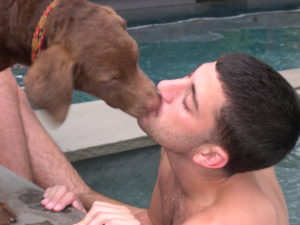![]()
quick bites
Relationships
Miscommunication causes most of the problems between humans and dogs.
Humans communicate mostly with words while dogs rely mainly on visual and olfactory cues. If you want to have a good relationship with your dog, you must learn to speak his language and teach him yours. Learn to read your dog’s body signals (eyes, ears, tail, head, body) and make it easier for him to learn your language by using simple, precise words, instead of sentences. In short, observe more and talk less.
Laughter is contagious
To help your dog feel better, try smiling and laughing. It can change his emotions and yours, and diffuse many stressful situations. Try laughing next time your dog looks worried and you might notice that he wags his tail and has a big smile on his face.

Developing a trusting relationship is more important than training.
Honor your dogs’ feelings. If you force him to do things, he might get suspicious of you and try to avoid you. He might also feel that he must protect himself from you. If your dog doesn’t trust you, he won’t obey you. Patience, kindness, and compassion are essential for every good relationship.

Dogs Just Want To Have Fun
Dogs are social animals who evolved with humans over 10,000 years ago. As a result, dogs seek our attention and are happiest when we play and interact with them. Most dogs don’t play very much by themselves or with each other. Instead, they will wait at the door for us to come out and play with them. If you only give your dog attention when he’s doing something wrong, (jumping, barking or stealing your socks) he will keep doing those naughty, attention-seeking behaviors. That’s because, from a dog’s point of view, any attention — even negative attention — is better than nothing. It’s therefore, a good practice to give your dog the attention he craves by sharing fun activities and rewarding him when he’s doing “nothing” — lying down calmly, looking at you, walking by your side — so he learns that he doesn’t need to act out to get your attention.
“To define is to limit.” oscar wilde
Labels like “aggressive,” “dominant,” and “stubborn” obscure the real issues and miss your dog’s true potential.
Splitting:
Teach your dog you have it covered. If you step in-between your dog and whomever or whatever is making him anxious, he should relax. Dogs and horses use splitting to protect each other from threats.
Be your dog’s advocate.
Don’t allow other people or animals to approach, touch, or handle your dog unless it’s OK with him. Don’t let anyone — even a trainer, veterinarian or groomer — intimidate, frighten or harm your dog. Your dog will be calmer and happier if he sees that you will protect him – no matter what.
Don’t expect your dog to be a better person than you are. Trish King
Humans and dogs experience frustration, anger, and fear and neither species handles it well all the time. (Think road rage!) Dogs instinctively try to avoid conflicts and most will not react aggressively unless they are terrified or pushed too far. Unfortunately, most people don’t notice the dog’s repeated warnings to back off until it’s too late. Most humans find it very difficult to resist temptation, especially if we’re tired or stressed. Think of our failed diets and exercise programs. So how can we expect our dogs to resist a roast sitting on the counter, an open garbage can or a human-scented shoe – especially if they’re alone or bored? We can help them, of course, by preventing access to those temptations, and providing fun things to do instead.
Dogs are our prisoners and have no choice in what happens to them. Trish King
Dogs have no say about where they’re living or with whom. It is up to us to provide the best environment possible, to help them adjust to different people and animals, and to make them feel as safe and comfortable as possible.
